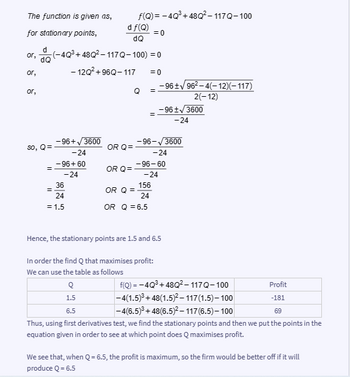
ENGR.ECONOMIC ANALYSIS
14th Edition
ISBN: 9780190931919
Author: NEWNAN
Publisher: Oxford University Press
expand_more
expand_more
format_list_bulleted
Question
is profit maximisation seen as local minimum or maximum? Is part (b) the correct way of doing first derivative? There is image of the questions, another image of the answers of part (a) and (b).

Transcribed Image Text:The function is given as,
for stationary points,
or,
d
or, (-4Q³+48Q²-117Q-100) = 0
dQ
-12Q² +96Q-117
or,
So,
Q=
=
-96+√3600
-24
=
-96+60
-24
36
24
= 1.5
df(Q)
dQ
OR Q=
f(Q)=-4Q³ +48Q²-117Q-100
=0
OR Q=
Q
OR Q =
= 0
=
=
-96+√96²-4(-12)(–117)
2(-12)
156
24
OR Q = 6.5
-96 ± √3600
-24
-96-√3600
-24
-96-60
-24
Hence, the stationary points are 1.5 and 6.5
In order the find Q that maximises profit:
We can use the table as follows
Q
Profit
f(Q)=-4Q³ +48Q²-117Q-100
-4(1.5)³ +48(1.5)²-117(1.5)-100
1.5
-181
6.5
-4(6.5)³ +48(6.5)²-117(6.5)-100
69
Thus, using first derivatives test, we find the stationary points and then we put the points in the
equation given in order to see at which point does Q maximises profit.
We see that, when Q = 6.5, the profit is maximum, so the firm would be better off if it will
produce Q = 6.5

Transcribed Image Text:The profit of a firm is described by the following function: f(Q) = -4Q^3 + 48Q^2 -
117Q 100 where Q is the quantity produced
a)
Find the stationary points for this function
b) Using the first derivative test, find for what value of Q is the profit maximised.
c) Find the feasible values of Q where the graph of the profit function is concave
up. Show working
Expert Solution
This question has been solved!
Explore an expertly crafted, step-by-step solution for a thorough understanding of key concepts.
Step by stepSolved in 3 steps

Follow-up Questions
Read through expert solutions to related follow-up questions below.
Follow-up Question
How is my answer correct? from what I heard f < 0 = maximum and f > 0 is minimum. the Q = 6.5 is above 0 which means its minimum and when substituting Q=6.5 to the profit function it gives 69, which above 0 which is minimum, how is it maximum?
Solution
by Bartleby Expert
Follow-up Questions
Read through expert solutions to related follow-up questions below.
Follow-up Question
How is my answer correct? from what I heard f < 0 = maximum and f > 0 is minimum. the Q = 6.5 is above 0 which means its minimum and when substituting Q=6.5 to the profit function it gives 69, which above 0 which is minimum, how is it maximum?
Solution
by Bartleby Expert
Knowledge Booster
Learn more about
Need a deep-dive on the concept behind this application? Look no further. Learn more about this topic, economics and related others by exploring similar questions and additional content below.Similar questions
- PLS HELP ASAP ON BOTHarrow_forwardNote:- Do not provide handwritten solution. Maintain accuracy and quality in your answer. Take care of plagiarism. Answer completely. You will get up vote for sure.arrow_forwardIndicate whether each of the following is an explicit cost or an implicitcost.a. A manager's salaryb. Payments to Dell for computersc. A salary forgone by the owner of a firm by operating his or herown companyd. Interest forgone on a loan an owner makes to his or her owncompanye. Medical insurance payments a company makes for its employeesf. Income forgone while going to collegearrow_forward
- Match the terms in the first column with the appropriate definition in the second column.arrow_forwardNote:- Do not provide handwritten solution. Maintain accuracy and quality in your answer. Take care of plagiarism. Answer completely. You will get up vote for sure.arrow_forwardThe total profit from the sale of q sweatshirts is: P(q) = 5q – 0.005q2 – 450. a. Calculate the additional profit earned when 450 sweatshirts are sold. ________ b. Calculate the additional profit earned when 750 sweatshirts are sold.arrow_forward
arrow_back_ios
arrow_forward_ios
Recommended textbooks for you

 Principles of Economics (12th Edition)EconomicsISBN:9780134078779Author:Karl E. Case, Ray C. Fair, Sharon E. OsterPublisher:PEARSON
Principles of Economics (12th Edition)EconomicsISBN:9780134078779Author:Karl E. Case, Ray C. Fair, Sharon E. OsterPublisher:PEARSON Engineering Economy (17th Edition)EconomicsISBN:9780134870069Author:William G. Sullivan, Elin M. Wicks, C. Patrick KoellingPublisher:PEARSON
Engineering Economy (17th Edition)EconomicsISBN:9780134870069Author:William G. Sullivan, Elin M. Wicks, C. Patrick KoellingPublisher:PEARSON Principles of Economics (MindTap Course List)EconomicsISBN:9781305585126Author:N. Gregory MankiwPublisher:Cengage Learning
Principles of Economics (MindTap Course List)EconomicsISBN:9781305585126Author:N. Gregory MankiwPublisher:Cengage Learning Managerial Economics: A Problem Solving ApproachEconomicsISBN:9781337106665Author:Luke M. Froeb, Brian T. McCann, Michael R. Ward, Mike ShorPublisher:Cengage Learning
Managerial Economics: A Problem Solving ApproachEconomicsISBN:9781337106665Author:Luke M. Froeb, Brian T. McCann, Michael R. Ward, Mike ShorPublisher:Cengage Learning Managerial Economics & Business Strategy (Mcgraw-...EconomicsISBN:9781259290619Author:Michael Baye, Jeff PrincePublisher:McGraw-Hill Education
Managerial Economics & Business Strategy (Mcgraw-...EconomicsISBN:9781259290619Author:Michael Baye, Jeff PrincePublisher:McGraw-Hill Education


Principles of Economics (12th Edition)
Economics
ISBN:9780134078779
Author:Karl E. Case, Ray C. Fair, Sharon E. Oster
Publisher:PEARSON

Engineering Economy (17th Edition)
Economics
ISBN:9780134870069
Author:William G. Sullivan, Elin M. Wicks, C. Patrick Koelling
Publisher:PEARSON

Principles of Economics (MindTap Course List)
Economics
ISBN:9781305585126
Author:N. Gregory Mankiw
Publisher:Cengage Learning

Managerial Economics: A Problem Solving Approach
Economics
ISBN:9781337106665
Author:Luke M. Froeb, Brian T. McCann, Michael R. Ward, Mike Shor
Publisher:Cengage Learning

Managerial Economics & Business Strategy (Mcgraw-...
Economics
ISBN:9781259290619
Author:Michael Baye, Jeff Prince
Publisher:McGraw-Hill Education